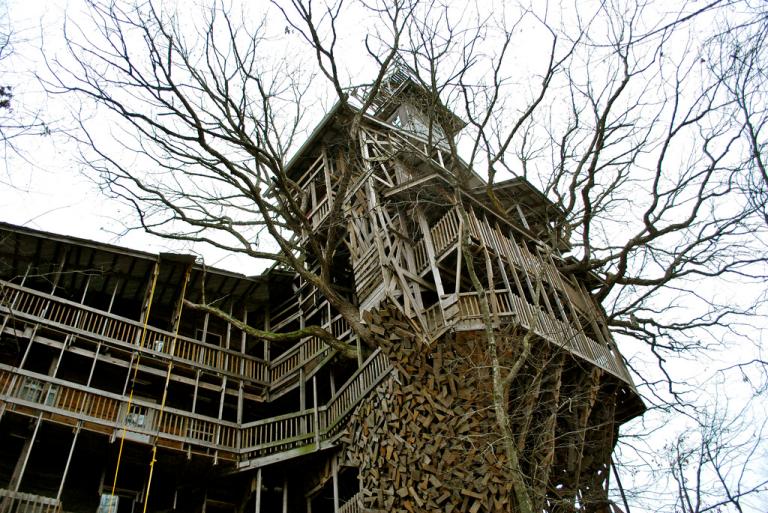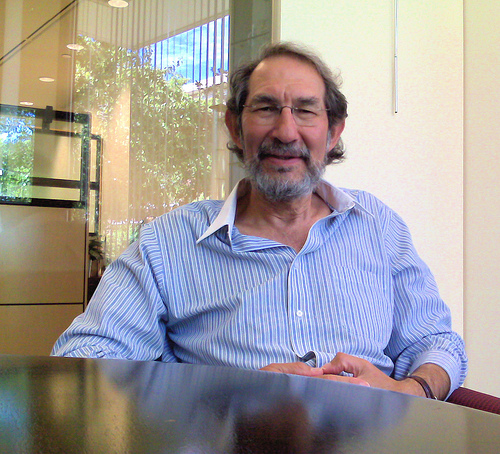 Photo: Steve JurvetsonThis story is excerpted form a longer piece in Urbanite.
Photo: Steve JurvetsonThis story is excerpted form a longer piece in Urbanite.
Imagine if someone concocted a method for turning cities inside out, so we could view their inner workings — their strengths and shortcomings, how they grow and thrive and die — at an almost cellular level. By analyzing a vast sweep of data, everything from how much money the city’s residents make to the numbers of miles in its sewer lines, this system could tell us just how successful a city has been, where it falls flat, and how it stacks up to other cities of its size. Would we, armed with this killer urban-wonk app, be able to pull off a feat that has eluded generations of urban planners, politicians, and sundry city boosters: turn a troubled municipality back from the brink?
Geoffrey West, a theoretical physicist who has taken to studying, in exquisitely rich detail, how metro areas work, thinks so. Along with a team of researchers at the Santa Fe Institute, where he serves as “distinguished professor,” West has quantified what we’ve long suspected about cities: Buzzing beehives of human activity churn up a honey of creativity and wealth. The bigger the hive, the more ideas and economic activity spew out of it. By slicing the beehive down the middle and investigating its parts — such as its crime, level of patent development, and population levels — the West team has been able to find common reference points of scale among cities or metro areas worldwide, ones that might lead to answers about what makes a city succeed.
He has emphasized what one could call “West’s Paradox”: Even though cities consistently deliver certain negatives — more disease, more poverty, and more violent crime than surrounding areas and small towns — the ideas and innovation they produce also provide the best hope for solving those problems. “The only way to deal with the problems cities present us with is to make better cities,” says West. “And the only way to ensure their health is to make sure they keep growing.”
We tend to view metropolises as complex one-of-a-kind admixtures of history, culture, and geography. West has effectively scientized the study of them by developing “a mechanistic theory that transcends the individuality of a city,” he says, one he hopes will complement traditional urban planning. He and his researchers corralled data from the U.S. Census Bureau and from governments worldwide on various urban systems. Then, he and Luis Bettencourt, another physicist and an external professor at the Santa Fe Institute, did what physicists do. They developed equations to figure out the shape and velocity of things.
Their findings dispute the notion that a particular city’s problems are uniquely its own. If, for example, you were to tell West that you live in an unnamed metro region with 2.5 million people, he can come up with a strong estimate of how much crime and how many paved roads you’ll have, among other metrics.
A native of Taunton in rural western England, West, 71, says the need for more predictive, science-based urban research is unquestioned. The world groans under the weight of 7 billion people, about half of them now living in urban areas. Even if cities weren’t the answer to our population problems, we’d somehow have to conjure up a belief that they were, West says. “Cities are popular for a reason,” he says. “They are how we take advantage of economies of scale.”
The city-as-beehive analogy might be apt in explaining West’s M.O. He takes his cues from nature. A onetime expert on particle physics, West began to move away from the field in 1993, when the federal government withdrew money earmarked for a supercollider project in Texas. He ended up looking into allometry, the study of scale and growth rates, and how it plays out in biology.
Famously among the thousands of scientists who have cited his work, West said that larger organisms, which have slower metabolisms, need less energy per gram of weight to move about than small ones, making them more efficient. An elephant, for example, is 10,000 times bigger than a guinea pig but only needs 1,000 times the energy to get around. This rhymed with the economies of scale West saw when, in 2002, he turned his gaze toward cities, where more people can share infrastructure and services, making them both more efficient and productive than less-dense human settlements.
But there’s a big difference between an elephant and a city. Biology plods sustainably along, with major changes taking place over tens of millennia or more. Cities, on the other hand, evolve by the day, and — if they’re successful — at faster and faster rates. That rate of growth is key. To keep working, cities must generate ever-more productive, even transformative ideas. When they do, people from the hinterlands and beyond will uproot themselves to buzz over to the beehive. Which, on a global scale, is what’s now happening: 1 million people, many of them border-crossers, move from farms and towns to cities every week. “It’s astonishing,” West says. “There’s nothing like this in nature.”
Not everybody is buying into West’s city-centric fascinations. Some researchers bristle at the notion that this ex-physicist’s stat-crunching stunts tell us anything new about how cities operate, much less offer a universal urban theory of everything. Joel Kotkin, a professor of urban development at Chapman University in Orange, Calif., insists that much of the economic vitality of metro areas is created outside the core of a city, in less-celebrated suburbs and exurbs. “The most successful areas in terms of jobs and income growth are generally low density, including the suburbs,” he says.
West’s vision of cities as idea hives might echo that of the well-known urban theorist Richard Florida — “creatives” and immigrants are good; stodgy old businesses, bad — but there’s also a streak of Thomas Malthus running through his work. Malthus is the fellow who inspired generations of environmental doomsayers by arguing (in “An Essay on the Principle of Population” in 1798) that humankind would soon breed and eat itself out of resources. Cities can indeed thrive on their own metamorphic creativity, as West suggests, but his corollary’s a bummer: This can’t go on forever.
The upward rise of cities stops when they run out of fuel, food, or social cohesion, or when they attempt to take in more people than they can handle. And in an era when some economists worry that all of the low-hanging fruit of high-yield capitalism has been picked, the growth engines needed to fuel larger, more inventive, and more successful cities may have run out of steam. “I, frankly, don’t think we can do this sustainably, at least not the way we’re growing cities now,” West agrees. “It’s not at all clear we can keep up the rate of growth we need. In fact, I rather doubt that we can.”
It might be a buzzkill for all those beleaguered burgs that are betting on the transformative power of the creative class, but West isn’t certain that small-scale entrepreneurship and micro-enterprise — the urban farming outfits, locavore restaurants, and boutique-y mini-manufacturers so celebrated by the creative class — can fully replace the industrial-age jobs that built many American cities in the first place. “We don’t know whether that’s the kind of innovation we need or not,” he admits.
But even if he can’t anticipate exactly what will work, West seems optimistic that something will. And whoever comes up with it will probably live in a city. “The great thing about cities is you can basically do anything — that’s their strength,” he says. “The sustainability of cities comes from this opening up, this embracing of diversity. Cities allow homeless and crazy people to walk around the streets. They allow people to do all sorts of creative and strange things. Corporations” — the latest study subject for West and company — “don’t tolerate those differences. And they die because of it.”




